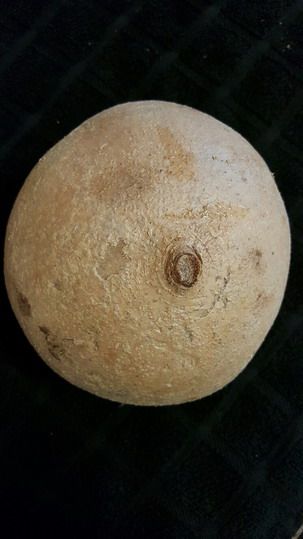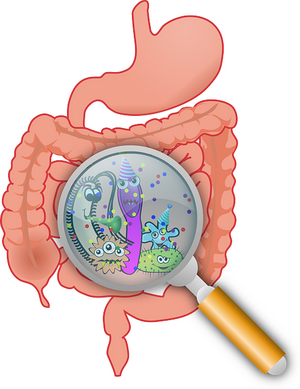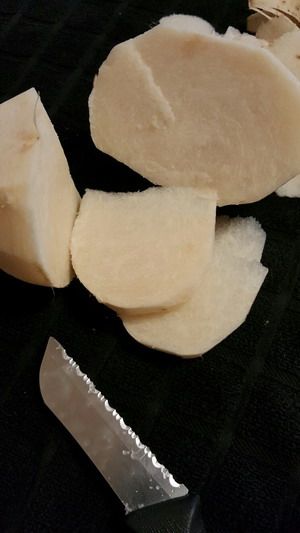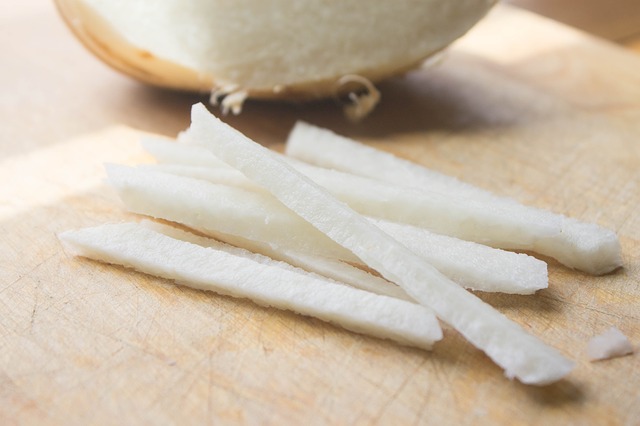 Jicama, sometimes referred to as Mexican turnip or yam bean, is a fascinating vegetable. It is actually the root to a legume – like a green bean. But don’t try to eat the beans on the Jicama as they are toxic. In fact the whole plant is toxic except for the inside of the root. The beans, leaves, stems, and the outer skin of the roots contain an organic toxin called rotenone which can cause Parkinson’s disease. But once you peel the root it is perfectly safe.
Jicama, sometimes referred to as Mexican turnip or yam bean, is a fascinating vegetable. It is actually the root to a legume – like a green bean. But don’t try to eat the beans on the Jicama as they are toxic. In fact the whole plant is toxic except for the inside of the root. The beans, leaves, stems, and the outer skin of the roots contain an organic toxin called rotenone which can cause Parkinson’s disease. But once you peel the root it is perfectly safe.
Why would I write about Jicama? Because a 4 ounce serving of Jicama contains over 5 grams of a special prebiotic fiber called oligofructose inulin. It is this fiber that gives the Jicama its mildly sweet taste. Oligofructose inulin is one of the plant fibers that specifically feed the healthy bacteria in our gut that have such huge impacts on our health.

There are 100 trillion bacteria in our gut – 10 times as many bacteria as there are cells in our whole body. In terms of DNA, we are actually 90% bacteria and only 10% human. The typical person has over 500 different species of bacteria living in his gut and everyone has different gut bacteria. The exact amounts and kinds of bacteria in our guts forms a unique bacterial fingerprint for each person that tells all kinds of information about that person’s life.
These gut bacteria are not passive passengers inside us. They produce neurotransmitters and chemical messengers that affect us in very many ways. The wrong gut bacteria can cause us to gain weight, or be depressed, or develop various diseases. That is why it is vitally important for us to support the growth of good-for-us gut bacteria and inhibit the growth of the bad bacteria.

Unfortunately for Americans, the foods we have been taught to love are precisely the foods that feed the bad gut bacteria that cause us ill health. Bad bacteria love simple starches and sugar. Bad bacteria basically love junk food. When we eat junk food we create a bacteria ghetto in our guts with all the problems we tend to associate with any ghetto: nasty gang warfare, graffiti, property destruction, bums, welfare dependents, bad attitudes and ill health. The bacteria equivalents of each of these grow in abundance when you eat junk food – especially sugar and if you are sensitive to them, grains.

Many foods we eat and medications we take actually damage the lining of the gut and this provides areas of the gut that bad bacterium especially like to grow on. Any foods we are sensitive to can damage the gut. Rancid or cooked polyunsaturated oils damage the gut lining. Many food chemicals made to prevent mold and oxidation of food damage the guts and common meds like aspirin and Motrin damage the gut. Now we even have to deal with antibiotics and pesticides in our foods that all damage the gut and promote the growth of the bad bacteria.
The answer of course is to eat healthy foods. But now our understanding of what a healthy food is has to expand beyond what we know about human nutrition. We have to consider what is healthy for our friendly bacteria passengers in our guts. Foods that are healthy for the growth of bacteria are called prebiotics. We are mostly familiar with probiotics – the actual good bacteria found in fermented foods and lots of probiotic supplements. But prebiotics are what feeds the probiotics.

For years the alternative community and probably for many years to come, the focus has been on taking supplemental capsules of good probiotics. This is a little bit helpful, but really, taking a billion good guys in a capsule does not have much of an impact on 100 trillion bacteria already in place in the gut. A few billion good guys taken as a supplement is such a tiny amount compared to the amount already present. It would be like having one good family move into a ghetto and expecting that to make everything wonderful.
Far more powerful is to alter what you are feeding the bacterial population as a whole at each meal. The right foods containing the right prebiotics will feed the good guys so they multiply, while omitting the foods that feed the bad guys, will starve the ugly bugs out. Proper nutrition is the real answer to how to shift the population of bacteria in our gut over to the ones that will promote our health and wellbeing. It does not happen over night if the gut lining is damaged and the bad guys have gotten entrenched. They can hang out for quite a while making the gut repair difficult. Certain nutrients and herbs can help speed this process along. In some cases fasting becomes helpful to seriously starve out the bad guys, while giving the gut lining a chance to rest and repair. I am working on a modification of my Green Fast protocol to adapt to this new information on prebiotic plant fibers to know which ones to include and which to avoid.

A word of caution here, if a SIBO condition is present in which the small intestine has a massive overgrowth of lots of bacteria, prebiotics will promote even more growth of bacteria. In SIBO (Small Intestine Bacterial Overgrowth) the problem is not necessarily bad bacteria, but just too many bacteria of any sort in the small intestine. The colon is designed to have very high bacterial loads. A valve called the ileocecal valve that is supposed to keep the hordes of bacteria out of the small intestine but open at the right times to allow the flow of digested food down into the colon can malfunction and allow the bacteria to backup into the intestine. In these cases the SIBO has to be resolved before we worry about supporting the good guy populations. With SIBO you want to avoid all foods that promote bacterial growth. Since bacteria mostly eat fiber, starch, and sugar, what is left is a diet of saturated fat, a little meat, and only a couple of vegetables that have been found not to promote bacterial growth. It is a challenging diet.

How do you know if you have SIBO? The classic symptom is bloating 3 to 4 hours after a meal. That is about how long it takes the meal to get down to the bacteria and feed them. But some people have such a bad case that they are bloated all the time. Look for the bloating to be centered around the belly button and below as opposed to bloating right after a meal that appears right under the sternum, which is a sign of a food reaction or digestive deficiency.

So if bloating is not your issue and you want to promote the growth of healthy bacteria to in turn promote your own health, then you want to eat a diet rich in healthy prebiotics or take prebiotics directly. This is where Jicama comes into the picture. Oligofructose inulin found in Jicama is one of the prebiotics that the good guys just love to eat. Jicama is also a low calorie and low carb vegetable that has none of the gut irritating tendencies that lots of other nuts and vegetables tend to have. Plant parts that are out where bugs and molds can attack them have developed natural chemical warfare to ward off these pests. These chemicals also affect our gut. Certain food preparation methods have been developed to minimize these problems like soaking seeds, nuts, and grains to wash off these chemicals, but modern food processing does not take the time to do these things.

Root vegetables tend not to have these defenses and are usually pretty safe to eat. Roots are where the plant stores its food for the winter. Tubers are the plant’s equivalent to a roll of belly fat designed to hold us over the winter without food. The Jicama we buy in the store is the roll of belly fat the Jicama vine uses to survive over the winter. Interestingly, just like humans, Jicamas root storage comes in a variety of sizes. Typically the roots are a couple to a few pounds in size. But tubers up to 50 pounds have been recorded.
Jicama is delightful eaten raw, sometimes with salt, lemon, lime, or chili powder. They make a wonderful addition to stir fries, or as a stand alone cooked vegetable with a wide assortment of herb and sauce pairings. Personally I like dipping my sliced Jicama into humus or guacamole.

So if you have never tried buying one of those funny looking brown lumpy root things at the grocery store, give it a try. Cut off the ends and use a paring knife to peel away the brown skin to reveal the crisp and lightly sweet white inside. Slice and enjoy.
